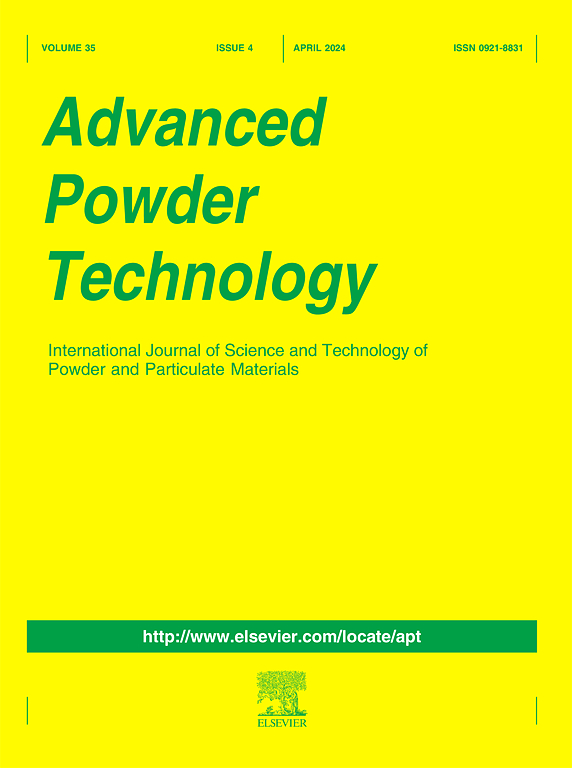用动态流程模拟优化工业连续流化床干燥机乳糖干燥过程的效率
IF 4.2
2区 工程技术
Q2 ENGINEERING, CHEMICAL
引用次数: 0
摘要
湿乳糖的流化床干燥在制药用乳糖粉的工业生产中起着至关重要的作用。目前,这种工艺通常使用经验操作参数进行控制,这可能会导致产品特性的变化以及资源和能源的次优消耗。因此,我们在论文中介绍的工作旨在解决这一问题,在流程模拟框架 Dyssol 中为湿乳糖干燥提出了一个新的动态流化床干燥器模型。该模型基于热量和质量平衡、热力学和粉末干燥动力学的基本方程实现。它能快速准确地预测各种湿乳糖流速、流化空气流速和流化空气温度下的产品含水量和排气温度。根据提出的模型进行了优化,为降低能耗和稳定产品特性提供了途径。此外,该模型还有助于建立一个数字孪生系统,对整个乳糖生产过程进行实时模拟和优化,超越了传统的流程表建模。在上游和下游处理过程中加入更多的工艺单元,可以更快、更有效地控制现有工艺,并促进更先进的优化技术的实施。本文章由计算机程序翻译,如有差异,请以英文原文为准。

Optimization of efficiency of lactose drying process in an industrial continuous fluidized bed dryer using dynamic flowsheet simulation
The fluidized bed drying of wet lactose plays a crucial role in the industrial production of lactose powder for pharmaceutical purposes. Currently, such a process is often controlled using empirical operating parameters, which may result in variability in product properties and suboptimal consumption of resources and energy. Hence, the work presented in our paper aims to address this issue by proposing a new dynamic fluidized bed dryer model for wet lactose drying in the flowsheet simulation framework Dyssol. This model was implemented based on fundamental equations for heat and mass balance, thermodynamics, and powder drying kinetics. It enables a fast and accurate prediction of the product moisture content and the exhaust air temperature for a wide range of wet lactose flow rates, fluidization air flow rates, and fluidization air temperatures. Optimization was conducted based on the proposed model, offering a pathway to reduce energy consumption and stabilize product properties. Furthermore, this model contributes to establishing a digital twin, which provides real-time simulation and optimization of the entire lactose production process beyond conventional flowsheet modelling. Incorporating further process units for the upstream and downstream treatments will allow for faster and more efficient control of existing processes and facilitate the implementation of more advanced optimization techniques.
求助全文
通过发布文献求助,成功后即可免费获取论文全文。
去求助
来源期刊

Advanced Powder Technology
工程技术-工程:化工
CiteScore
9.50
自引率
7.70%
发文量
424
审稿时长
55 days
期刊介绍:
The aim of Advanced Powder Technology is to meet the demand for an international journal that integrates all aspects of science and technology research on powder and particulate materials. The journal fulfills this purpose by publishing original research papers, rapid communications, reviews, and translated articles by prominent researchers worldwide.
The editorial work of Advanced Powder Technology, which was founded as the International Journal of the Society of Powder Technology, Japan, is now shared by distinguished board members, who operate in a unique framework designed to respond to the increasing global demand for articles on not only powder and particles, but also on various materials produced from them.
Advanced Powder Technology covers various areas, but a discussion of powder and particles is required in articles. Topics include: Production of powder and particulate materials in gases and liquids(nanoparticles, fine ceramics, pharmaceuticals, novel functional materials, etc.); Aerosol and colloidal processing; Powder and particle characterization; Dynamics and phenomena; Calculation and simulation (CFD, DEM, Monte Carlo method, population balance, etc.); Measurement and control of powder processes; Particle modification; Comminution; Powder handling and operations (storage, transport, granulation, separation, fluidization, etc.)
 求助内容:
求助内容: 应助结果提醒方式:
应助结果提醒方式:


